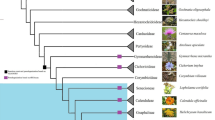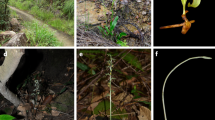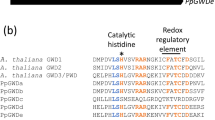Abstract
PHOTOSYNTHESIS is the hallmark of plant life and is the only plastid metabolic process known to be controlled by plastid genes1,2. The complete loss of photosynthetic ability, however, has occurred on several independent occasions in parasitic flowering plants3,4. Some of these plants are known to lack chlorophyll and certain photosynthetic enzymes4, but it is not known to what extent changes have occurred in the genes encoding the photosynthetic apparatus or whether the plants even maintain a plastid genome. Here we report that the nonphotosynthetic root parasite Epifagus virginiana has a plastid chromosome only 71 kilobases in size, far smaller than any previously characterized land plant plastid genome5. The Epifagus plastid genome has lost most, if not all, of the 30 or more chloroplast genes for photosynthesis and most of a large family of plastid genes, the ndh genes, whose products may be involved in a plastid respiratory chain6–9. The extensive changes in Epifagus plastid gene content must have occurred in a relatively short time (5–50 x 106 yr), because Striga asiatica, a related photosynthetic parasite, has a typical complement of chloroplast genes for photosynthesis and chlororespiration. The plastid genome of Epifagus has retained transcribed ribosomal RNA and ribosomal protein genes, suggesting that it expresses one or more gene products for plastid functions not related to photosynthesis.
This is a preview of subscription content, access via your institution
Access options
Subscribe to this journal
Receive 51 print issues and online access
$199.00 per year
only $3.90 per issue
Buy this article
- Purchase on Springer Link
- Instant access to full article PDF
Prices may be subject to local taxes which are calculated during checkout
Similar content being viewed by others
References
Jensen, R. G. in The Biochemistry of Plants Vol. 1 (eds Stumpf, P. K. & Conn, E. E.) 273–313 (Academic, New York, 1980).
Sugiura, M. A. Rev. Cell Biol. 5, 51–70 (1989).
Kuijt, J. The Biology of Parasitic Flowering Plants (University of California Press, 1969).
Press, M. C. Trends ecol. Evol. 4, 258–263 (1989).
Palmer, J. D. in Plant Gene Research, Vol. 6: Organelles (1991).
Bennoun, P. Proc. nath. Acad. Sci. U.S.A. 79, 4352–4356 (1982).
Matsubayashi, T. et al. Molec. gen. Genet. 210, 385–393 (1987).
Fearnley, I. M., Runswick, M. J. & Walker, J. E. EMBO J. 8, 665–672 (1989).
Maione, T. E. & Gibbs, M. Pl. Physiol. 80, 364–368 (1986).
Musselman, L. J. A. Rev. Phytopathol. 18, 463–489 (1980).
de la Harpe, A. C., Visser, J. H. & Grobbelaar, N. Z. Pflanzenphysiol. 103, 265–275 (1981).
Press, M. C., Shah, N. & Stewart, G. R. in Proceedings of a Workshop on Biology and Control of Orobanche (ed. ter Borg, S. J.) 96–106 (LH/VPO, Wageningen, The Netherlands, 1986).
Bricaud, C. H., Thalouarn, P. & Renaudin, S. J. Pl. Physiol. 125, 367–370 (1986).
Musser, R. L. thesis (Duke University, North Carolina, 1979).
Walsh, M. A., Rechel, E. A. & Popovich, T. M. Am. J. Bot. 67, 833–837 (1980).
Palmer, J. D. A. Rev. Genet. 19, 325–354 (1985).
Schuster, W. & Brennicke, A. Pl. Sci. 54, 1–10 (1988).
Lonsdale, D. M. Biochem. Plants 15, 229–295 (1989).
Nixon, P. J. et al. J. biol. Chem. 264, 14129–14135 (1989).
Wu, M., Nie, Z. Q. & Yang, J. Pl. Cell 1, 551–557 (1989).
Muller, J. Bot. Rev. 47, 1–142 (1981).
Palmer, J. D. Trends Genet. 6, 115–120 (1990).
Siemeister, G. & Hachter, W. Curr. Genet. 15, 435–441 (1989).
Siemeister, G., Bucholz, C. & Hachter, W. Plant molec. Biol. 14, 825–833 (1990).
Machado, M. A. & Zetsche, K. Planta 181, 91–96 (1990).
Kirk, J. T. O. & Tilney-Bassett, R. A. E. The Plastids. (Elsevier/North-Holland, New York, 1978).
Doyle, J. J. & Doyle, J. L. Phytochem. Bull. 19, 11–15 (1987).
Maniatis, T., Fritsch, E. & Sambrook, J. Molecular Cloning. A Laboratory Manual. (Cold Spring Harbor Laboratory, New York, 1982).
Palmer, J. D. Meth. Enzym. 118, 167–186 (1986).
Shinozaki, K. et al. Plant molec. biol. Rep. 4, 111–147 (1986).
Hamby, R. K., Sims, L., Issel, L. & Zimmer, E. Plant molec. biol. Rep. 6, 175–192 (1988).
Stern, D. B., Dyer, T. A. & Lonsdale, D. M. Nucleic Acids Res. 10, 3333–3340 (1982).
Author information
Authors and Affiliations
Rights and permissions
About this article
Cite this article
dePamphilis, C., Palmer, J. Loss of photosynthetic and chlororespiratory genes from the plastid genome of a parasitic flowering plant. Nature 348, 337–339 (1990). https://doi.org/10.1038/348337a0
Received:
Accepted:
Issue Date:
DOI: https://doi.org/10.1038/348337a0
This article is cited by
-
Complete chloroplast genomes of five Cuscuta species and their evolutionary significance in the Cuscuta genus
BMC Genomics (2023)
-
Hemiparasitism and host range of Castilleja fissifolia L.f. (Orobanchaceae) in the high tropical Andes
Plant Ecology (2023)
-
Genome-wide identification of MST, SUT and SWEET family sugar transporters in root parasitic angiosperms and analysis of their expression during host parasitism
BMC Plant Biology (2019)
-
Gene loss and genome rearrangement in the plastids of five Hemiparasites in the family Orobanchaceae
BMC Plant Biology (2018)
-
Molecular evolution of anthocyanin pigmentation genes following losses of flower color
BMC Evolutionary Biology (2016)
Comments
By submitting a comment you agree to abide by our Terms and Community Guidelines. If you find something abusive or that does not comply with our terms or guidelines please flag it as inappropriate.



